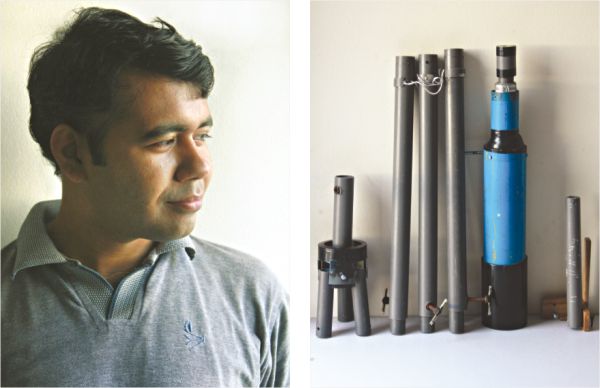Young Crafts
When The Sky is (not) The Limit
Rakibul Hasan
Photos: Kazi Tahsin Agaz Apurbo
 |
Shafayet Azad.
|
The parts of the telescope. |
Remember while visiting outside the city, you would look up at the clear night sky and would be amazed by the presence of a millions of stars, each light-years away from the earth, or after watching a Sci-Fi movie, how a debate would break out among friends about the existence of life in a distant planet? The stars, their constellations, numerous planets and the overall space have always been a source of wonder and imagination for humans. And for Shafayet Azad, a passionate young astronomer, the thirst to know the mysteries of the space was more than a temporary infatuation. When he was a student of Mohammadpur Central College, Shafayet developed an active interest in astronomy. He became a member of the Astronomical Society of Bangladesh and built up a collection of books and journals about astronomy and rare images of the space. However, the thing he needed most to observe the stars, planets, asteroids and to understand the constellations was a telescope. Since a celestial telescope would be quite expensive to buy, as a student Shafayet was not in a position to afford one. Nevertheless, as the saying goes-- 'when there is a will, there is a way', Shafayet planned to build a telescope himself. Eventually after reading a lot of books about optics, doing some research on the internet and spending a considerable amount of money to buy materials to build a telescope, Shafayet became successful to assemble a full fledged celestial telescope in 2012. It took him almost three years to come up with his first telescope since he had to learn about the suitable lenses for different types of telescopes, precise diameters for the telescope cylinders, had to procure expensive lenses from abroad and go through the trial and error process several times. However it was just the beginning. Soon after his success on assembling a celestial telescope, the idea of developing economically feasible celestial telescopes crossed Shafayet's mind and since then he started to take orders to make telescopes at an economic rate especially for amateur astronomers, most of who happened to be students from both urban and rural areas.
 |
The assembled telescope on the tripod. |
The lens of the telescope. |
The telescopes Shafayet makes are Galilean telescopes, which can be best described as reflective telescopes with one convex lens and a concave lens. The concave lens serves as the ocular lens or the eyepiece, while the convex lens works as the objective. The lenses are situated on either side of a tube such that the focal point of the ocular lens is the same as the focal point for the objective lens. Shafayet's telescope has a 2 inch Plano-Convex lens, an 8x eyepiece and its focal length is 75 centimetre. The body of the telescope is mostly made of plastic, while Shafayet imports the lenses for his telescope from Dubai.
When asked how an enthusiastic but inexperienced astronomer should choose the right telescope to buy?, Shafayet suggestet to look for three things in a telescope: aperture, portability and the price. Considering these three factors, the telescopes made by Shafayet are most suitable for the students who want to discover the night sky as amateurs. The mid-range aperture of Shafayet's telescope lets one observe the craters of the moon, binary stars, star clusters, Orion Nebula, the Galilean moons of Jupiter and so on. The telescope is very easy to carry as it is only 4.5 metres in length and weighs a bit more than 1 kilogram. Currently, Shafayet is also making tripods for his telescopes, which are 4.5 metre in length weighing 2.5 kilograms. The tripod is very flexible to use as it can be bended according to its user's needs and can carry up to 5 kilograms of weight. One of the most interesting features of the telescopes made by Shafayet is its remarkably economical price. Shafayet sells the telescope with a tripod and a star catalogue (a simple device that can be used to find local time by aligning the dial with stars and setting the date and time), all of which comes in a portable bag at a price of Tk 4,500 only, while an imported Galilean telescope with the same 2 inch lens would cost between Tk 20,000 to Tk 26,000 at Dhaka's Baitul Mukarram market.
"To be an astronomer one has to be a bit of an eccentric. Astronomers can be found on their own rooftops at the dead of night with their eyes set on telescopes to enjoy the plethora of celestial objects seen in the night sky or they might climb a hilltop during a meteor shower just to get a clear view of the sky,"says Shafayet. The fun of enjoying the mysteries of space, in Shafayet's words, is something beyond explanation.
If astronomy is your hobby and you want to monitor stars, track asteroids or hunt comets with a telescope of your own, contact Shafayet Azad at 01670126534 or email him at s_astro2000@yahoo.com.
|
|
|
